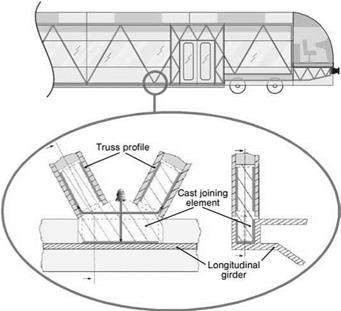While for locomotives, bonding is used almost exclusively to fix protective foils, it also offers a wide field of applications in tramways, regional traffic or long-distance transport. The head-end of the German ICE, for example, is a bonded integral plastics construction. The windows are fitted by bonding, as are the sidewalls, ceilings, floorings and equipment such as lamps, hinges, strips and coverings. Anti-graffiti foils are applied by means of adhesive bonding to protect the vehicles against vandalism. The efficient and low-priced ‘re-design’ concept for the modernization of old trains and tramways is also based upon bonding technology.
The profiles and joint elements are joined to form the body-in-white that is then precisely aligned. Only at this moment is the adhesive applied by injection via feeding ducts in the joint elements. The structure is not subject to any heat distortion, no straightening is required, and prefabricated components may be installed without any further adjustment (European Patent No. 0780279; see Figure 8.11).
Bonding is used not only in rail vehicles but also in rails. Inductive rail traffic safety systems are still based on insulating rail joints that interrupt the electrical conductivity of the welded rail system. These screwed fished joints, made from steel, are high-strain joints that may only be secured against loosening by means of adhesive bonding. The nonconductive adhesives interrupt conductivity together with another insulating element placed between the rail joints (Figure 8.12).
In rail joints that are exclusively joined by screws, important deformations occur at lower temperatures due to thermal contraction ofthe steel. Although the high-strain steel screws are not capable ofpreventing these deformations, ifthe fishes are joined
|
Figure 8.11 Injection-bonded framework in a railway car. (Illustration courtesy of Dorel Verlag). |
to the rails by means of adhesive bonding in addition to the screws, these deformations do not occur.
For ‘permanent ways’, the rails are fixed to sleepers made from wood or concrete by means of so-called ‘ribbed plates’. In conventional sleeper construction the rails are joined to the sleepers by means of screws (see Figure 8.12). However, for concrete grounds, underground railways and in tunnels, as well as in present-day fixed-bed installations, these screw joints may be replaced by adhesive bonds which also take on the damping function that formerly was provided by ballast beds. For this, the adhesive used must have a high elasticity and bond-line thickness.
Another example of the successful use of bonding technology is that of magnetic levitation vehicles. It is common practice in transformer and electric motor manufacture that the sheet laminates used as the core material in linear induction motors that form the monorail. These must be free from the eddy currents that occur at right — angles to the lamination direction. In the case of magnetic levitation vehicles, the sheets are made from special steel alloys and have a thickness of 0.5 mm. They are entirely bonded to each other, as no mechanical locking elements, such as screws, may be used for electromagnetic reasons.
8.2.4
 9 ноября, 2015
9 ноября, 2015  Pokraskin
Pokraskin 
 Опубликовано в рубрике
Опубликовано в рубрике 